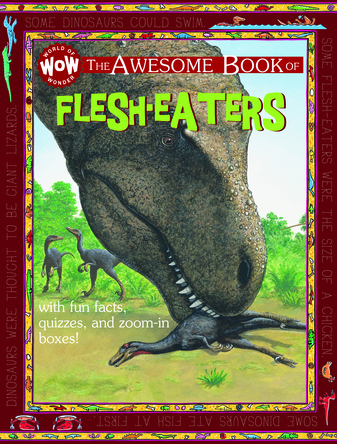Extrait du livre Flesh Eaters
Discover for yourself the most amazing things about these ferocious creatures that roamed Spot Earth millions and millions and count! of years ago. What did they eat? How did they live? Where did they go? What new discoveries are scientists making? Chapter by chapter, this book gives you the latest information about these fearsome meat eaters, from the smallest turkey-sized dinosaurs to the amazing Tyrannosaurus rex. Learn about how flesh-eating dinosaurs became fossils— where they are found and who looks for them—and find out how you can name a dinosaur after yourself! Q: Why watch out for these boxes? A: They give answers to the dinosaur questions you always wanted to ask. Dinosaur bits : Look out for these boxes to take a closer look at flesh-eaters’ features. Awesome facts : Watch out for these diamonds to learn more about the truly weird and wonderful facts about flesh-eaters and their world.
Dinosaurs could walk from Africa to America without getting their feet wet. When they lived Dinosaurs lived between 230 and 65 million years ago (mya). This is a very long time ago. It’s hard enough to imagine hundreds of years ago, let alone millions. Dinosaurs are dated according to the geological time scale, which is used to age rocks. Geologists figure out the ages of ancient rocks by studying radioactive elements in them, and by analyzing fossils. At the start of the age of the dinosaurs, the continents were all joined together as one great supercontinent called “pangaea.” Over millions of years, the Atlantic Ocean opened up and pangaea split apart. The continents drifted (moved slowly) to their present positions. They are still moving about an inch (a few centimeters) each year. Q: how did a flesh-eating dinosaur become a fossil? A: Small meat-eating animals ate the flesh from the dead dinosaur’s bones. Some bones rotted. Others were buried under layers of sand or mud. These turned into fossils over time, as tiny spaces in the bones filled with rock. Millions of years later, the fossilized bones are uncovered by water or wind action. Paleontologists dig the fossilized bones out of the rock and clean them, making sure they don’t fall apart. They make maps and take photographs at the dig site so that they can tell later exactly where everything was found.
Newly discovered dinosaurs in Argentina may have been bigger than T. rex. Flesh-eaters Flesh-eating dinosaurs, called “theropods,” ranged from turkey-sized dinosaurs to the awesome Tyrannosaurus rex. Theropods of different sizes ate prey of different sizes. This meant that several species could live side-by-side. Big meat eaters, like T. rex, ate the larger plant eaters. T. rex probably wasn’t very fast or very bright. It didn’t need to be. It was so big, it could attack almost any other dinosaur. In the Late Cretaceous of Canada, smaller meat eaters lived alongside the huge T. rex. Troodon hunted lizards, mammals, and even insects. It relied on speed and intelligence. Ornithomimus ate small plant-eating dinosaurs and the young of larger ones. T. rex used its massive teeth to tear strips from prey’s flesh.
Deinonychus may have been small, but it was one of the fiercest dinosaurs. What makes a flesh-eater ? All flesh-eaters had sharp claws and sharp, curved teeth that pointed backwards. So if the prey struggled, it moved further into the gaping jaws. One of the most fearsome flesh-eaters was Deinonychus. Deinonychus was only as tall as a ten-year-old child, so it had to work in packs to bring down large prey like this Tenontosaurus. Q: How did Deinonychus use its toe claw? A: It had one huge claw on each foot, on the second toe. When running, it held the claw off the ground so it would not become blunt. But when it attacked, its victim raised its foot and slashed downwards, through a half circle. Balancing : Two-legged dinosaurs were like see-saws, balanced over their back legs. The front of the body had to weigh the same as the tail, or the dinosaur would fall on its nose. So flesh-eaters had to hold their backbones nearly flat when they ran, and flick their massive tails around to keep perfect balance. Awesome facts : Most dinosaurs were not very smart, but Deinonychus had a big brain. It had to have a good sense of balance, excellent eyesight, and be able to communicate.



























